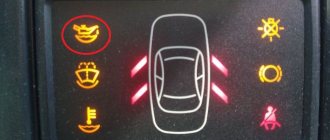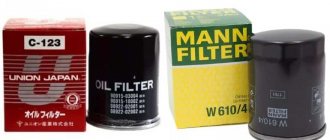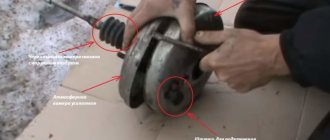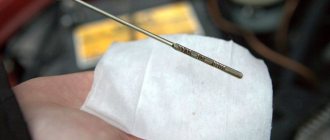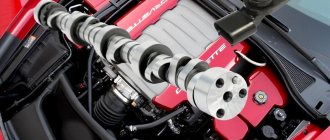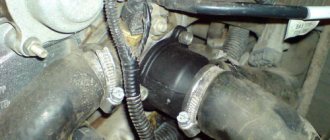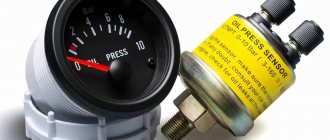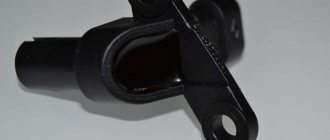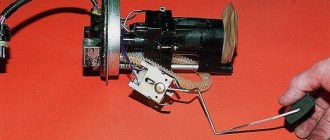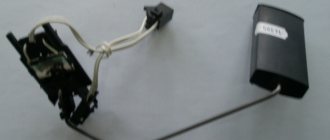The VAZ-2112 engine is developed on the basis of the VAZ 2110 engine, but has many modified and changed parts.
Units with 16 valves have the following modifications:
- engine 21120 volume 1.5 l (GLI luxury version);
- engine 21124 volume 1.6 l (years of production from 2004 to 2008);
- unit 21128 with a volume of 1.8 liters (100 hp, luxury version of the car from Super-auto JSC).
Using the example of a classic 21120 engine with a volume of 1.5 liters on a VAZ 2112, we will show how the most common maintenance procedure is performed - changing the oil.
Check frequency
Every car owner knows about the importance of changing engine oil. When determining the frequency, the manufacturer’s recommendations and personal experience are taken into account. Some drivers change the lubricant every 5,000 km, while others wait until the last minute and carry out the work every 20,000 km.
The average is 8,000 - 10,000 km or once a year. This option is optimal in terms of the price of motor oil and its ability to perform its functions.
You need to check the oil level in the engine crankcase:
- Immediately after replacing it.
- At least 2 times a month (by the time the sensors notify you of the problem, it will be too late).
- After a certain mileage, depending on the make of the car and the engine installed on it, on average every 1000 km.
- When signs of malfunctions appear: black, bluish, white smoke from the exhaust pipe, loss of power, leaks from under seals and gaskets, etc.
Many people check the oil level every day before leaving, and this is also correct, especially if the car has high mileage.
When to change and how much oil to pour into the VAZ 2112 engine
Changing the VAZ 2112 oil is carried out along with replacing the filter every 15,000 km.
The design differences between engines 21120 and 21124 from their 8-valve counterparts did not affect the volume of oil poured into the engine. For 16 valve engines 21120 and 21124 it is the same 3.5 liters.
When replacing VAZ 2112 engine oil, please note that the stated volume for changing the oil is 3.5 liters and includes an additional 300 ml, which is poured into the oil filter.
But be that as it may, the process of filling engine oil needs to be controlled by measuring the lubricant level with a dipstick.
How do you currently check the engine oil level?
Despite the fact that cars produced nowadays are stuffed with modern electronics, the oil level in their engine is still checked using a conventional dipstick.
The latter is located in a sealed hole in the cylinder block and there is always easy access to it.
Of course, someday the situation will change and data on the amount of oil in the engine crankcase will be displayed in front of the driver on the display.
Such cars are already appearing on the market, but they are mostly premium, for example Mercedes w211 or Volvo XC60, and they do not have direct access to information about the amount of lubricating fluid in the engine; for this you need to activate the electronic dipstick function, but more on that below.
In any case, it is important to know how to properly check the oil level and why it is needed.
Functionality check
More or less experienced drivers can determine that it is the sensor that is causing confusion in the car’s operation, since there are no noticeable signs of oil leakage. Therefore, the first priority is to check the condition of the device that monitors the lubricant level.
The check is performed as follows:
- The car is placed on an overpass or inspection hole;
- The motor protection is removed. It can be put aside for a while;
- Now find the oil level sensor in the underbody space;
- Turn on the car's ignition. This way you can supply power to a device that may have failed;
- Disconnect the wires going to the sensor;
- Using a voltmeter, connect the probes to ground and the connecting block;
- If the voltmeter shows 12 volts, then the sensor is working normally.
But in the absence of tension, we can talk about one of three reasons for such a situation:
- The display unit is broken;
- There are defects on the contacts;
- There is a break in the wiring in the sensor circuit.
Therefore, if the wiring is in good condition and the contacts are clean, then further actions will consist of replacing the fuel level sensor on your VAZ 2110.
Consequences of incorrect oil level
There is an opinion among inexperienced drivers that the more oil is poured into the engine, the better, since there is no need to check it often.
But it is important to understand that if the lubricating fluid is above the upper mark of the dipstick, then its excess will enter the crankcase ventilation system, and this is dangerous for the catalyst.
This can also lead to an increase in pressure in the lubrication system, and this, in turn, can adversely affect the condition of the gaskets and seals and subsequently lead to their extrusion.
Due to the low level of working fluid, air is sucked into the oil pump, i.e. some engine parts will run dry, and this will reduce the interval until the unit is overhauled.
Also, during the measurement, you can check the condition of the lubricant and replace it in time, and this is also important.
How the dipstick works
There is no point in considering the design of the probe itself, everything is clear here, let's talk about the marks, because you need to navigate by them when taking measurements.
Most car brands follow one principle: the lower mark L is the minimum level, the upper mark F is the maximum. The designations “MIN” and “MAX” may also be found.
Also on some dipsticks there are marks for measuring the oil level at cold and hot.
But that’s not all; in order to measure readings correctly, you need to adhere to certain rules and conditions, which we will talk about below.
Features of checking the oil level on a cold and hot engine
There are so-called two castes of drivers, some claim that it is best to check the oil level on a cold engine, others, on the contrary, on a hot one. But the truth, as often happens, is in the middle.
IMPORTANT: The situation described below is when the dipstick does not have the “cold” and “hot” check marks.
As we know from physics and chemistry, any substance contracts in the cold and expands at high temperatures. This also applies to motor oil.
Let's imagine a situation where measurements are carried out on a cold engine at a temperature of minus 100C. The oil is compressed and its level on the dipstick has moved down. They topped it up as stated in the car's operating manual and warmed up the engine.
As a result, the working fluid warmed up, expanded and occupied a larger volume. Those. the level has become elevated (the consequences of this are described above).
If you take level measurements immediately after stopping the engine, the oil will not have time to drain into the crankcase and the readings will be incorrect. You need to wait a few minutes until the still heated and not very viscous liquid drains into the crankcase.
At the same time, it will cool down a little, but this will not greatly affect the accuracy of the measurement results. And what’s important is that this method can be safely used both in winter and summer.
Also keep in mind that non-original (fake) oils “behave” differently - they can harden like jelly even in hot summer weather.
Oil in the air filter VAZ 2112
In normal condition, the air filter should remain dry after any period of use of the machine. If, upon opening the lid, you see oil stains on the filter itself, in the groove of the housing or in the crankcase, then urgent action must be taken.
There are several reasons for the appearance of oil:
- poor compression;
- use of additives;
- high oil level;
- wear of oil seals;
- burnt and sunken oil scraper rings;
- poor quality repairs at service stations;
- crankcase ventilation failure;
- valve adjustment is impaired;
- oil pump is faulty;
- clogging of the tubes from the upper valve to the injector;
- absence and malfunction of the oil trap in the corrugation.
Considering that the Zhiguli hatchback models differ only in the number of valves and the height of the head, oil accumulates in the air filter of the VAZ 21124 for the same reasons as in the base version of the car.
In any case, if you find that oil gets into the air filter of the VAZ 2112, you should start by checking the oil level. The most common reason is the overflow of excess liquid.
Requirements for carrying out repair and maintenance work on VAG series vehicles
Many car owners do not bother checking their engine oil. As noted above, the machine is placed on a flat surface, and after a few minutes of standing, the dipstick is taken out and the level is checked.
Information on this subject is provided on the Internet based on the experience of car owners. It is difficult to find official data on this issue.
As an example, you can take information from ELSA - documentation that sets out the requirements for carrying out repair and maintenance work on VAG series vehicles.
Level check
At the first stage, you need to find out where the oil is located, and here everything depends on the part of the scale:
- A - no refilling is needed.
- B - it is permissible to add a little lubricant.
- C - topping up is required.
Conditions
An important point is the conditions that must be observed when performing work.
General instructions, except for V6 diesel and V8 gasoline engines:
- oil temperature - not less than 60 degrees Celsius;
- the waiting time after turning off the motor is several minutes, which is enough for the lubricant to drain into the pan;
- horizontal position of the car.
For V6 diesel engines the following requirements apply:
- oil temperature 90 degrees Celsius (warming up to this level is required);
- wait 2 minutes for the oil to drain into the pan;
- horizontal position of transport.
V8 gasoline engines are tested taking into account the following requirements:
- lubricant temperature - 90 degrees Celsius;
- Idle for 60 seconds;
- turn off the engine and pause for 5 minutes to allow the oil to drain (the process is slower);
- level control for 60 seconds;
- the car is horizontal.
Verification algorithm
Now let's look at the inspection instructions on VAG series cars.
Do the following:
- Remove the dipstick and wipe it with a clean cloth.
- Insert it into place until it stops and remove it again.
- Look at the oil level on the scale.
- Assess the situation and decide whether refilling is necessary.
The approach discussed above, as a rule, corresponds to the generally accepted algorithm. At the same time, experienced drivers recommend keeping the level between the Min and Max marks, and checking it in the morning before starting the engine.
VAG experts recommend a slightly different approach, focused on checking with heated oil.
Checking the oil level in the Lada Granta engine
The algorithm of actions is the same (see above). But when measuring the oil level in a Lada Granta, there is one feature that many people do not know about.
The crankcase pan is structurally equipped with an antifoam plate, which is located parallel to the bottom of the pan.
It serves to calm and prevent foaming of the liquid and for normal operation of the oil pump.
This plate has two holes, the main one for the oil intake and the second for the dipstick.
In the Lada Granta, this hole is slightly offset, so when measuring the oil level, the dipstick rests against the edge of this hole and does not go in completely.
Those who know about this get used to it and no problems arise, but those who don’t know how to bend the feeler gauge.
But this is not the only problem. When removing the probe, it touches the edge of the hole in the defoamer plate, which is at the level of the top mark when the probe is inserted.
As a result, the oil film moves smoothly along the dipstick from mark F to L, which misleads the driver. Therefore, here you need to adhere to the rule - the level is checked not at the edge of the oil on the dipstick, but in a dry place. The probe needs to be rotated, viewed and analyzed.
How much oil to pour into the "ten"
Quite often, the owners of the corresponding car have a question - how much VAZ 2110 oil is needed for normal engine operation. According to the manufacturer's recommendations, this volume is 3.3 liters. But experienced owners are not limited to the manufacturer’s recommendations and claim that in practice you can fill in from 3.5 to 4 liters of engine oil.
Returning to the choice of oil fluid, it is worth paying more attention to the viscosity indicator. Each brand is characterized by its own characteristics, but all have a common, firmly established designation. The first digit of this marking indicates the viscosity of the oil at sub-zero temperatures. The lower this indicator, the better the oil viscosity. The second digit of the marking reflects the viscosity indicator at high temperature.
Having understood the categories of oils and learned how much oil to fill the VAZ 2110, you should study in more detail the reasons for its replacement. The main factor requiring replacement is the deterioration of the properties of the oil during its operation. Like other raw materials, motor oil is subject to the aging process. If you adhere to the established regulations, you should replace it every 30 thousand kilometers of the vehicle.
When choosing cheap, low-quality oil, you need to be prepared for the corresponding negative consequences. After a little time, you can observe phenomena such as a peculiar crunch at the moment of gear shifting or the appearance of a noise effect in the gearbox. When regularly checking the level, car owners sometimes encounter a problem - VAZ 2110 oil leaks.
Moreover, leakage can occur both inside the engine and outside. The main cause of leakage is failure of oil seals or wear of gaskets. Under such circumstances, the best solution would be to replace all worn parts. To be more sure, you can change the gasket located on the filler cap. It would also be a good idea to tighten the fasteners.
As an urgent and short-term solution to the problem, you can use special additives. If oil is leaking inside the engine, it is recommended to replace the rings.
Other VAZ cars
Let's look at how to check the oil level on VAZ series cars using the example of the VAZ 2112 and Lada Priora 16 valves.
Level measurements on these vehicles are carried out only on a warm engine. The probes here have a special appearance - a corrugated area with marks along the edges without letters.
Therefore, if the engine is cold, you will have to start it and warm it up until the fan turns on.
Then turn off the engine, wait 3-5 minutes until the oil drains into the crankcase and take measurements, see the algorithm above.
Since the dipstick itself between the marks has a corrugated shape, this causes a problem for many drivers.
Everything is simple here - the working fluid must be in the grooved zone, then the level is considered normal. But where this place should be, opinions differ.
Experienced drivers recommend proceeding from the operating conditions of the vehicle.
If the VAZ 2112 and Lada Priora are operated under normal conditions on flat terrain, then it is considered normal if the oil level is in the middle in the corrugated zone.
If cars are driven on moderately rough terrain, then the normal level may be 2/3 from the bottom mark in the corrugated zone, and if in mountainous terrain, then 3/4.
Also, many experienced car owners rely on the number of engine revolutions.
If during driving the number of crankshaft revolutions does not exceed 3000 rpm, then the oil level can be kept in the middle, if more than 4000 - at 3/4 of the lower mark. Filling 1 liter means raising the level from the lower to the upper marks.
Materials and replacement regulations
For all 16-valve engines on 2112 hatchbacks, the volume of the lubrication system is no different. It is 3.6 liters. When replacing, pour 3.3, and if the filter is changed, then 3.4 liters (plus another 100 ml into the filter itself). The choice of material does not depend on the engine type.
| Brand | Viscosity | API quality class |
| LIQUI MOLY OPTIMAL | 10W40 | SL/CF |
| LUKOIL-SUPER | 5W40, 10W40, 15W40 | SG/CD |
| LADA SUPER | 5W40, 10W40, 15W40 | SG/CD |
| ESSO ULTRA | 10W40 | SL, SJ/CF |
| MOBIL SUPER S | 10W40 | SL, SJ/CF |
| SHELL HELIX PLUS | 10W40 | SL/CF |
| HAVOLINE EXTRA | 10W40 | SL/CF |
| ZIC A PLUS | 5W30, 10W30, 10W40 | SL |
| MANNOL RACING | 15W40 | SL/CF |
| NOVOIL-SINT | 5W30, 5W40 | SG/CD |
| NOVOIL-SUPER | 5W30, 5W40, 10W30, 10W40, 15W30, 15W40, 20W50 | SG/CD |
| UTEC NAVIGATOR | 5W40, 10W30, 10W40, 15W40, 20W40 | SG/CD |
| MANNOL ELITE | 5W40 | SL/CF |
| ESSO UNIFLO | 10W40, 15W40 | SL, SJ/CF |
| TNK SUPER | 5W40, 10W40, 15W40 | SL, SJ/CF |
| SHELL HELIX SUPER | 5W40, 10W40 | SL/CF |
| MOBIL 1 | 0W40 | SL, SJ/CF |
| MOBIL SUPER M | 10W40, 15W40 | SL, SJ/CF |
| VALVOLINE DURABLEND | 10W40 | SL/CF |
| MANNOL CLASSIC | 10W40 | SL/CF |
| VISCO 2000/3000/5000 | 10W40 or 15W40 or 5W40 | SL/CF |
| LUKOIL-LUX | 5W40, 10W40, 15W40 | SJ/CD |
| MANNOL EXTREME | 5W40 | SL/CF |
On a working engine, the oil level between changes remains above the MIN mark. That is, they do not top up. In general, on the VAZ-2112, oil changes are performed once every 15 thousand km. The filter is changed at the same time.
The use of API SF oils on engines 21124 or 21120 is unacceptable. There are no such materials on our list.
Toyota RAV 4, Corolla, Camry
The oil level in Toyota RAV 4, Corolla and Camry cars is checked using the algorithm described above.
Since these models do not have o and “hot” on the probes, the engine warms up, waits 5 minutes and measurements are taken. You need to focus on all the same indicators - 0.5 (middle of the probe), 2/3 and 3/4.
On Toyota RAV 4, depending on the engine model, the dipstick may be corrugated on one side or smooth on all sides. There may also be different designations - Max and Min or F and L.
The Toyota Corolla dipstick is smooth without any letter designations, there are only lower and upper marks. Measurements are carried out the same way.
On a Toyota Camry, depending on the engine model, the dipsticks can also be different, one may have the letters F and L, the other may simply have marks.
But this does not change anything; the oil level on the Toyota Camry is checked in the same way as indicated above.
Mercedes w211
The peculiarity of checking the oil level in a Mercedes w211 car is that you won’t find a dipstick there, it simply isn’t there, so don’t waste your time searching.
The w211 only provides an electronic probe, which is located in the form of a float in the engine crankcase. By the way, the w210 e280 has a probe and electronics, which is much more convenient.
In order to measure the amount of mass in the crankcase, you need to activate the electronic probe. The data will be displayed on the instrument panel.
The car must be on a horizontal platform. Insert the key into the ignition and turn it to the right once. Go to the menu and find the speed.
Press the reset button 3 times.
The battery voltage will be displayed.
Now, to find the electronic probe, press the arrow button shown in the photo 1 time.
A menu will appear.
Turn on the ignition by turning the key to the right one more step. After a few seconds, the display will show the engine oil level in liters. In our case it is 6.1 liter, which is the norm.
The following indication may appear on the display:
Where is the engine oil dipstick located?
Dipstick for measuring oil fluid
If you decide to check the level of oil material in a car, then you need to find a special “sensor”. The dipstick for measuring engine oil is usually located on the right or left of the engine, near the oil filler plug.
The probe is equipped with a comfortable small handle and it can be of different shapes. The color of this handle is usually red, yellow or orange. If you cannot find the dipstick near the engine, then pay attention to the engine cylinder block. The handle usually sticks out from this block.
Important: In a car with an automatic transmission, there are two metal rods near the engine: 1 - for checking the oil level in the engine, 2 - directly in the gearbox itself. Don't mix up these rods. It is prohibited to insert a rod from the engine compartment into the gearbox and vice versa. Oily material from the gearbox must not get into the engine compartment. This can lead to car failure.
Ford Focus 2
The car is also placed on a flat surface, the engine is turned off and wait 5 - 10 minutes until the oil drains into the crankcase.
The measurement algorithm is no different from that described above. Everything is also checked the second time.
The Ford Focus 2 dipstick has only risks, there are no letter designations. There are also no indicators for “cold” and “hot”, so we take measurements only on a warm engine.
Allowed oil level readings are 0.5 (the middle between the marks), 2/3 and 3/4 of the distance from the bottom mark.
Above the top line, drain off the excess; below the bottom line, add more.
Volkswagen Polo sedan
The dipstick for measuring the oil level in the Volkswagen Polo sedan engine has two marks, lower and upper, in the grooved area. Do not confuse with marks further down and up the dipstick.
Measuring the level is no different from the previous ones, just place the car on a flat surface, turn off the engine and wait 5 - 10 minutes.
The check is also carried out the second time. The oil level should be midway between the marks in the grooved area or 2/3 and 3/4 of the distance from the bottom mark.
The dipstick is filled with oil, the dipstick is in oil: why, then how to determine the oil level in the engine?
The dipstick is filled with oil.
Many car enthusiasts face the problem of a “dirty dipstick” when it is filled with oil. Below we will look at how to solve this problem.
Why is this happening? Causes of the problem:
- When checking the oil, the car was standing on an uneven surface.
- When the dipstick was removed, drops of oil at the end stained the dipstick hole.
- The check was carried out, the car was not yet warmed up or, on the contrary, overheated. After running, it is better to wait 5 to 10 minutes for the engine to become warm.
How to determine the engine oil level in this case? Here are the tips:
- Measurements must be taken on a flat surface, otherwise the measurement can immediately be considered incorrect.
- It is necessary to warm up the car to its operating temperature, and after stopping the engine, wait 5 minutes, and then measure the oil level.
- To get a better measurement, you need to drive a little, so the car is completely adjusted to normal operation.
Follow all these recommendations and you will be able to accurately understand what the oil level is in your car. If this does not help, then you should contact a service center, otherwise the machine may experience serious damage.
Volvo XC60
Volvo XC60 cars are equipped with D3, D4, D5 engines, which can be equipped with either two types of probes at the same time, electronic and conventional, or only electronic.
For example, on the Volvo XC60 D5 205 and 2.4D 175 there are two types of dipsticks, but the usual dipstick is very small and is located at the very bottom of the engine and is difficult to reach. You need to either lift the car or drive it into a pit.
Therefore, they mainly check the oil level on the Volvo XC60 electronically and for this:
- Get into the car and close the door;
- Insert the key into the ignition;
- Press and hold the START-STOP button for a few seconds;
- The on-board computer will go into “ON” mode;
- We look under the steering switch until the oil gauge appears;
- We activate the mode and see the computer readings;
- This completes the check.
Audi Q5
On the AUDI Q5, the oil level is also checked with an electronic dipstick, but here the manufacturer has gone overboard with this matter. Why? You will understand further.
Algorithm of actions:
- Turn on the ignition;
- Simultaneously activate and hold the “SETUP” and “CAR” buttons;
- Release the buttons when the hidden menu appears;
- Go to “CAR” - “Carextdevicelist” - “Oil level gauge” and activate the latter;
- Next, go to “Carmenuoperation” - “Oil level” and set the value to “5”;
- Press and hold the "Return" and "CAR" buttons to close the hidden menu;
- To reboot the system, click the buttons shown below;
- After reboot, go to “Oil level”;
- If the oil level is normal, the message “Engine oil level OK” will be displayed. It will also be visible where the level is between the MIN and MAX marks.

